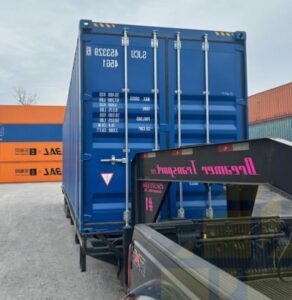Are Shipping Containers Waterproof?
Shipping containers are used worldwide for cargo transport, storage, and even housing projects. But one common question that arises is: Are shipping containers waterproof?
The short answer is that shipping containers are designed to be weathertight, not completely waterproof. They can withstand rain, snow, and even ocean spray without letting water seep in, but they aren’t built to be fully submerged or impervious to long-term exposure to moisture without maintenance.
In this guide, we’ll explore how shipping container doors, seals, and other design features contribute to weathertight protection, and we’ll share expert tips to keep your container dry.
Understanding Shipping Container Waterproofing
Let’s get straight to the point—shipping containers are built to be weathertight, not completely waterproof.
Think of them like a good work jacket—they’ll keep you dry in the rain, but you wouldn’t go swimming in one. They are designed to handle rain, snow, and ocean spray without letting water seep inside, making them highly effective for cargo protection.
What Does "Weathertight" Mean?
A weathertight shipping container means that while it prevents rain, wind, and dust from entering, it isn’t completely sealed against water penetration under extreme conditions. This is why inspecting the shipping container door, gasket seals, and roof panels is essential for long-term use

How Shipping Containers Resist Water
Shipping containers are designed with multiple weathertight features to keep moisture and water out:
Corten Steel Construction
Both standard containers and high cube containers are made from Corten steel, a corrosion-resistant material that forms a protective rust layer to prevent deeper corrosion. This is the same durable material used in bridges and structural steel.
Seamless Welded Seams
Unlike traditional storage sheds, shipping containers have welded seams that prevent leaks, similar to how a farm silo is sealed.
Gasket Door Seals on the Shipping Container Door
A crucial part of shipping container weatherproofing is the gasket door seal around the shipping container door, including both the left hand door and right hand door. These rubber seals prevent water from seeping in when the doors are closed properly.
Container Air Vents for Moisture Control
Strategically placed container air vents help regulate internal moisture levels and prevent condensation buildup, which can cause rust and mold inside.
ISO 1161 Corner Castings for Structural Strength
Shipping containers use ISO 1161 corner castings, ensuring stability when stacking or modifying them. This helps prevent misalignment and reduces the risk of leaks forming due to shifting or impact damage.
Can Shipping Containers Leak?
While containers are designed to be weathertight, they can develop leaks over time due to:
- Rust and Corrosion – If the protective coating wears off or the container sits in standing water, rust can weaken the metal, especially around the roof and corner castings.
- Damaged Gasket Door Seals – The gasket door seal around the shipping container door can crack, dry out, or weaken over time, reducing its effectiveness.
- Dents and Structural Damage – Impacts during transport, stacking, or container modification can create weak points where water can seep in.
Common Leak Points in Shipping Containers
If you suspect your container might be leaking, check these common areas:
- Roof Panels – Heavy impacts or prolonged exposure to moisture can weaken the roof.
- Shipping Container Door Seals – The gasket door seal should be checked regularly and replaced if cracked.
- Corner Castings – Since these points bear a lot of weight when stacking, they can develop stress fractures.
- Container Modifications – Any aftermarket container modification, such as adding windows, vents, or additional doors, must be properly sealed.
How to Ensure Your Shipping Container Stays Waterproof
If you’re using a container for long-term storage, container modification, or even housing, follow these maintenance steps to keep it weathertight:
Regularly Inspect for Rust and Holes
Check the roof, walls, and corner castings for any rust spots or holes. If you spot rust, sand it down and apply a protective coating.
Check and Replace Gasket Door Seals
The gasket door seal on both the right hand door and left hand door should be intact and flexible. If it’s dry or cracked, replace it immediately.
Apply a Waterproof Coating
Use a marine-grade paint or sealant to add an extra layer of protection. Rubberized coatings are particularly useful for roofs.
Use a Container Lock Box
A container lock box not only enhances security but also prevents water from getting into the locking mechanisms, reducing rust and wear.
Install a Sloped Roof or Canopy
If using the container for long-term storage, adding a sloped roof or covering can prevent water from pooling and reduce the risk of leaks.
Consider Bridge Fittings for Stacked Containers
When stacking high cube containers or standard containers, using bridge fittings ensures a tight and stable connection, preventing water ingress.
FAQ: Shipping Container Waterproofing
Can I make a shipping container 100% waterproof?
Yes, but it requires additional sealing, such as applying rubberized coatings, using welded seams for any modifications, and installing extra weatherproofing layers.
Do container air vents let water in?
No, container air vents are designed to allow airflow while preventing rain or moisture from entering. However, if they become clogged or damaged, they can contribute to condensation issues inside.
Are high cube containers more prone to leaks?
Not necessarily. High cube containers have the same structural integrity as standard containers, but their extra height means you need to be mindful of roof drainage when placing them outdoors.
How long does a shipping container last before it starts leaking?
A well-maintained container can last 20-30 years without significant leaks. Regular inspections and maintenance can extend its lifespan even further.
Can I use a shipping container underground without leaks?
If you plan to bury a container, you’ll need serious waterproofing, such as reinforced walls, a drainage system, and external waterproof membranes. Containers are not designed to handle underground pressure without modification.
Final Verdict: Are Shipping Containers Waterproof?
From my experience, shipping containers are tough and reliable for keeping cargo dry, but they are not submarine-tight.
Think of them like a well-built storage shed—they’ll keep your belongings safe and dry with proper weatherproofing and maintenance.
If you’re planning to use a container long-term, whether for business storage, housing, or a container modification project, adding extra waterproofing is a smart investment. It’s just like applying a protective coat to your tractor—a little prevention goes a long way
Internal Links to Explore Further
- Do You Need a Permit for a Shipping Container Home? Everything You Need to Know
- Shipping Container Zoning Laws by State: A Complete Guide for Homeowners & Businesses
- Complete Guide: Shipping Container Zoning Laws in All 50 States
- Best Locks for Shipping Containers: Protect Your Cargo with High-Security Solutions
- Best Shipping Container Security Camera Systems: 24/7 Surveillance & Remote Monitoring
- How to Burglar-Proof a Shipping Container: The Ultimate Security Guide
- Fire Safety Tips for Shipping Container Storage
- Shipping Container Fireproofing Methods: Protecting Your Fire-Resistant Storage and Living Spaces
- Insurance for Shipping Container Homes: Everything You Need to Know
- How to Comply with Shipping Container Building Codes: A Step-by-Step Guide
- Seismic Safety for Shipping Container Structures: The Ultimate Guide to Earthquake-Resistant Designs
- Are Shipping Containers Safe to Live In?
Get quote!

No strings attached 💯